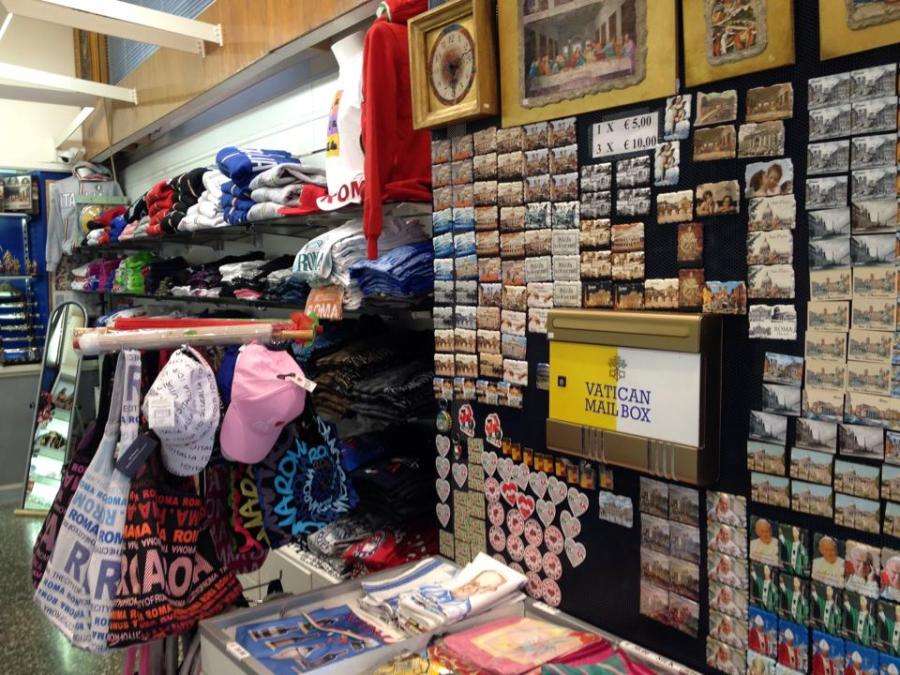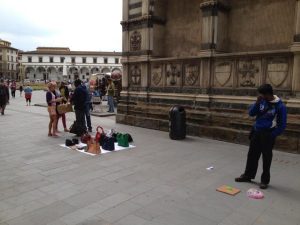
On a 2015 trip to Florence and Rome (my first visit to both cities), I had the opportunity to take in some of the more popular sites, such as the Pitti Palace and the Roman Forum, along with several museums and basilicas that are as plentiful in those parts of Italy as Walmart and waffle houses are in the U.S. Both cities were flooded with tourists, which made popular attractions like Michelangelo’s David a challenge to see without advanced booking and marked virtually every experience as one that was shared with camera-totting strangers. At some of these sites, this meant being herded through an enclosed space by stern security guards, as I encountered at the Sistine Chapel:
Silence, silencio, no photos.
The sheer abundance of it all — from people to works of art to the rich and flavorful cuisine — was overwhelming at times, offset by more tangible realities on the ground, such as Nigerian merchants of black market leather purses and the many Indian migrants who traded in sunglasses, scarfs, and colorful tennis ball sized toys that would be tossed down on a wooden plank, splatter, and re-form in a matter of seconds … pick up and repeat. In Rome, unlike in Florence, they even made a noise — “whaaah” — that could be heard at uneven intervals on popular streets throughout the city.

These mundane fixtures of the social landscape were perhaps among the most commonly shared experiences of the (mainly) American, Canadian, Chinese, German, and Indian tourists, many of whom, I imagine, were vying for something more “ancient,” “authentic,” or even “sacred” than could be found in their own backyards.
Mundane experiences of this kind are what Robert H. Sharf describes as things that one “participate[s] in” or “live[s] through,” which he considers unproblematic in the descriptive sense, since the referents are easily found in the social or public world … “whaaah.” (“Experience” in Religious Experience: A Reader, 141)
When it comes to those things that are said to evoke an “authentic” or “sacred” experience, such as gazing upon the frescos of Michelangelo in the Sistine Chapel or walking through the ruins of the Roman Forum, the language often shifts from the descriptive (e.g., “those dudes selling toys”) to the ineffable (e.g., “I’m at a loss for words”). In this latter sense, something like Sharf’s second notion of experience may come into play, which he describes “as a subjective ‘mental event’ or ‘inner process’ that eludes public scrutiny.” (141)
Without denying the strong affects that viewing great works of art or walking through places like St. Peter’s Square can evoke in the eyes of a beholder (e.g., aesthetic beauty, historical importance, personal significance, etc.), Sharf’s point is to challenge the idea that “experience” is somehow an autonomous or private affair. As he suggests:
Such judgments are inevitably predicated on prior ideological commitments shaped by one’s vocation… one’s socioeconomic background… one’s political agenda, one’s sectarian affiliation, one’s education, and so forth. (144)
I couldn’t help but think of Sharf’s distinctions (after the fact, that is, while on the plane ride home) after feeling underwhelmed in places like the Sistine Chapel, while finding personal meaning in unexpected and even “mundane” spaces.
One such experience came at the Borghese Villa in Rome (admittedly not an everyday space), which is home to many works of art from the ancient past, the Renaissance, and the contemporary period of Cardinal Scipione Borghese (1579-1633), nephew of Pope Paul V (1552-1621), who was an obsessive collector and patron to the likes of Bernini, Caravaggio, and Paul Rubens. Scipione apparently had a penchant for ancient sculpture, which was part of a desire to re-ignite a new golden age, where a connection to pre-Christian history was, for him, a commodity of the highest value.
While gazing upon Bernini’s Apollo and Daphne, which was one of several highlighted pieces in the Borghese Villa, I was struck by his attention to detail, especially the life-like quality of the laurel leaves, though it was only after hearing about the plaque or cartouche at the sculpture’s base that it became significant to me. As the story goes, the presence and celebration of a Pagan myth in the villa of a Cardinal was somewhat of a scandal back in the day, and was later justified by the addition of a moral couplet in Latin by Cardinal Mafeo Barberini (later Pope Urban VIII), which reads:
Bernini’s Apollo and Daphne, which was one of several highlighted pieces in the Borghese Villa, I was struck by his attention to detail, especially the life-like quality of the laurel leaves, though it was only after hearing about the plaque or cartouche at the sculpture’s base that it became significant to me. As the story goes, the presence and celebration of a Pagan myth in the villa of a Cardinal was somewhat of a scandal back in the day, and was later justified by the addition of a moral couplet in Latin by Cardinal Mafeo Barberini (later Pope Urban VIII), which reads:
Those who love to purse fleeting forms of pleasure, in the end find only leaves and bitter berries in their hands.
Much like Sharf’s observation quoted above, in this instance my own ideological commitments, sectarian affiliation, (e.g., as a former Catholic in my youth) and education as a scholar of religions all contributed to making this little tidbit of information memorable and significant to me.
Throughout the duration of my 11-day visit to Florence and Rome, which was occasioned by a wedding where I served as the best man, and included a day-trip to Siena, San Gimignano, and Pisa, my mother asked me why I seemed to be just as interested in the street merchants and kitschy souvenirs as I was to “see” those sites (to “do” being the more commonly used verb, as in “I did San Gimignano”) that Italy was famous for?

My answer, which I withheld from her at the time and promised to provide in the form of this blog post, is fairly straight forward. Those (mostly) Nigerian and Indian migrants (all men), selling purses, scarfs, and novelty toys, along with the many recurring souvenirs (with some variations) — from staples like Romulus and Remus nursed by a wolf and pictures of the Coliseum, to figurines of Pinocchio and David, model Vespas and Ferraris, and bobble-heads of Don Corleone and Pope Francis — are all, though to varying degrees, fleeting products of this time and place and say more about what we value (or what we perceive others will value) than those ancient ruins — re-modeled, re-branded and re-purposed over hundreds, and in some cases thousands of years. Being witness to this unique configuration of people in certain roles and objects elevated to a temporary place of significance was as interesting and, dare I say, “sacred” to me as anything else since it represented an experience of a moment in history that would soon pass and never be quite the same again.
Even the various Vatican gift shops, made legit by the presence of an officially sanctioned mailbox, were populated with these “mundane” trinkets, nestled alongside an abundance of newly made coins, plaques, and photographs of the recently sanctified Popes John XXIII and John Paul II, often photo-bombed by Pope Francis. Pope Benedict, by contrast, was as rare in the souvenir trade as a woman in the Vatican hierarchy, which says more, perhaps, about this time and place than all the frescos in Rome.

Given my own background, tastes, and preferences, it was these seemingly “mundane” or “profane” things that were of greater interest to me than any so-called “sacred” or revered object that I came across in all of Italy (the Boboli Gardens in Florence notwithstanding). While I suspect that I am among a minority in this regard and imagine that such objects would appear less significant if they were found in my own backyard, my quasi-sacralization of these trinkets is hardly an autonomous or private affair, as Sharf points out, but conditioned by unconventional, though no less meaningful, interests that allowed them to stand out as significant for me.
.
.An earlier version of this post originally appeared on the Bulletin blog.
